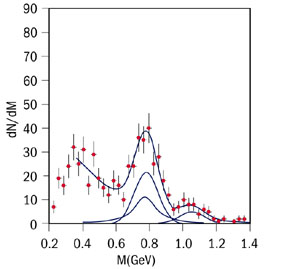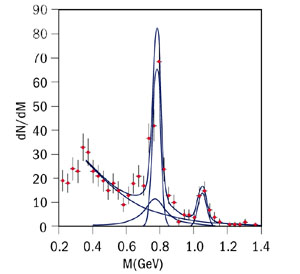
The RHIC collider at Brookhaven now dominates the world stage for high-energy, heavy-ion collisions. It is set to run later this year with its sights on the full design energy of 200 GeV per nucleon, following its initial running at a lower energy in 2000. The main goal of this research is to explore the transition from ordinary hadronic matter to quark-gluon plasma (QGP) – matter as it is thought to have existed at the birth of the universe.
Meanwhile, a new experiment at CERN’s Super Proton Synchrotron is also poised to provide new results, following a decision last November to continue CERN’s heavy-ion programme.
The NA60 experiment will complement the new research programme at RHIC, meaning that CERN will continue to be a player in a field currently awaiting the big ALICE experiment at the Large Hadron Collider.
CERN’s heavy-ion programme began in 1986, with the initial goal of identifying the phase transition from confined hadronic matter to the deconfined QGP state. Last year, those conducting the experiments concluded that they had produced compelling evidence for a new deconfined state of matter in which quarks roam freely (see Opening the door to the quark–gluon plasma).
Several signals for the formation of QGP had been anticipated, and many of them were observed by CERN experiments. Among the most important of these was a sharp reduction in the number of charm-anticharm mesons, J/psi and psi primes emerging from the highest energy-density collisions. This was caused by the tumultuous conditions of the plasma preventing the charm quarks and antiquarks from binding together. Another signal that was observed was an increase in the number of lepton pairs emerging from the collisions. These are the signals on which NA60 will focus.


The NA60 detector builds on the existing apparatus of the NA50 experiment with the addition of two new silicon detectors. One is placed in the beam and measures the interaction point with a precision of 20 µm. The other, placed after the target, is a silicon pixel telescope of almost 1 million channels in a 2.5 T magnetic field, which will vastly improve the mass resolution for muon pairs. Together these detectors will enable the experiment to measure J/psi and psi prime suppression more cleanly, and to measure charmed D-meson production in heavy ion collisions for the first time.
NA60 will run with protons this year, followed by indium and lead ions in 2002 and 2003. NA60 has chosen indium to test the current interpretation of the pattern of suppression observed by NA50 in lead-lead collisions. Verification of the effect seen by NA50 would bring conclusive evidence that the deconfined quark-gluon phase sets in under SPS conditions. It would also provide fundamental information on the mechanisms driving the transition. Furthermore, NA60’s excellent dimuon mass-resolution will allow the experiment to investigate other signals for deconfined matter, including the production of rho, omega and phi mesons, and to check whether the observed intermediate-mass dimuon excess is due to thermal dimuons emitted from free quarks in the plasma.
The NA49 experiment has also received a short extension to complete its data at 40, 80 and 158 GeV per nucleon study with points at 20 and 30 GeV per nucleon. This should allow the onset of the transition to be ascertained with a greater degree of certainty.





